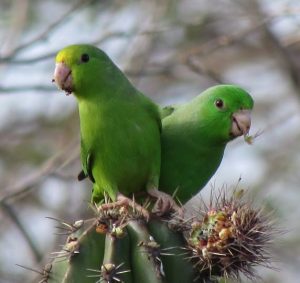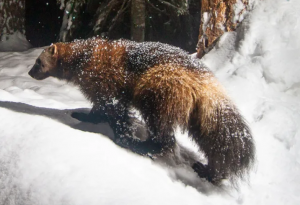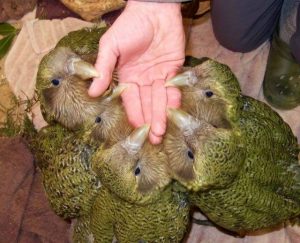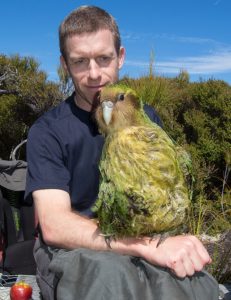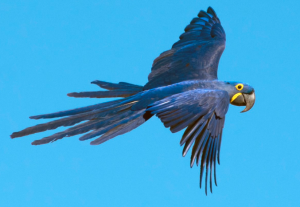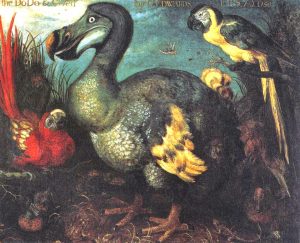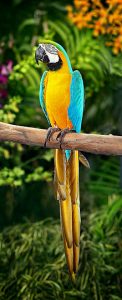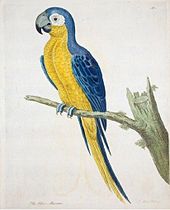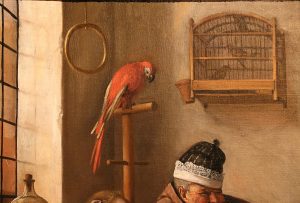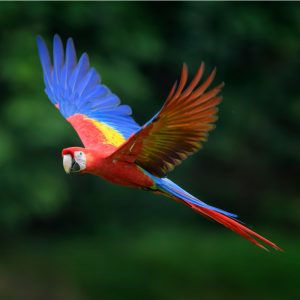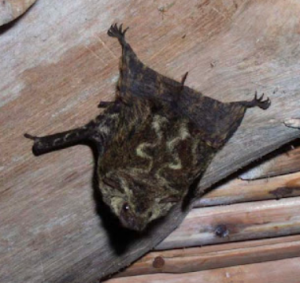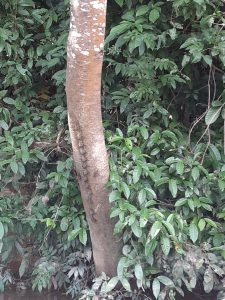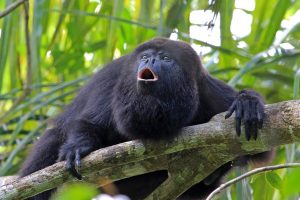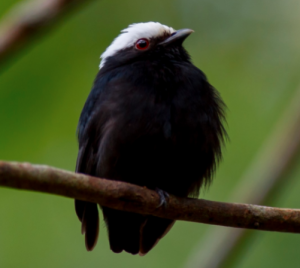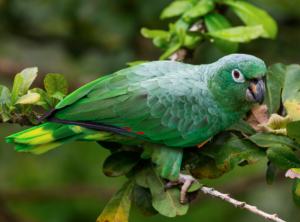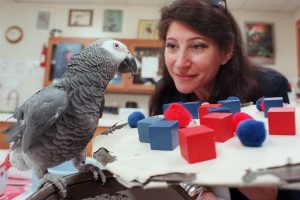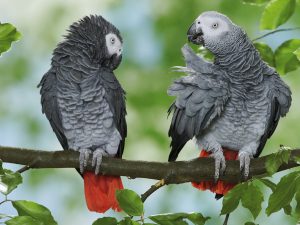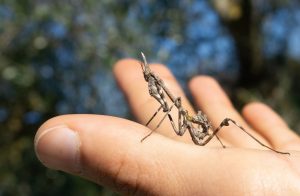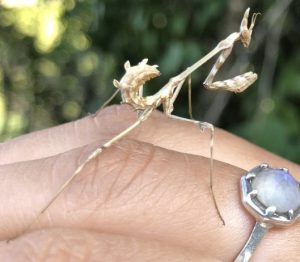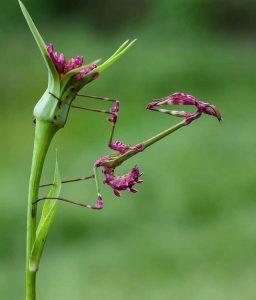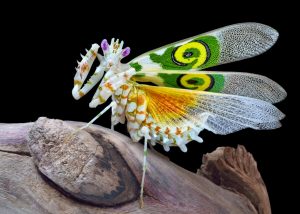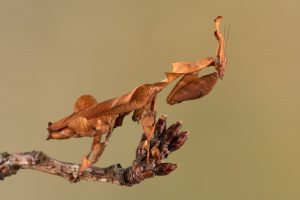Podcast: Play in new window | Download (Duration: 17:34 — 19.2MB)
Subscribe: | More
It’s our fifth updates and corrections episode, with some fun information about a New Zealand parrot, suggested by Pranav! Thanks also to Llewelly, Zachary, Nicholas, and Simon who sent in corrections.
Further reading:
Vitiligo
Tyrannosaurus remains hint at three possible distinct species
Study refutes claim that T. rex was three separate species
The reign of the dinosaurs ended in spring
Impact crater may be dinosaur killer’s baby cousin
California mice eat monarch butterflies
‘Hobbit’ human story gets a twist, thanks to thousands of rat bones
Playground aims to distract mischievous kea
The kea showing off the bright colors under its wings:
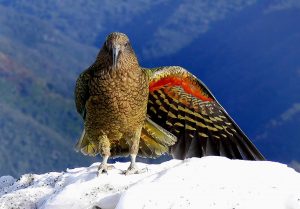
A kea jungle gym set up to stop the birds from moving traffic cones around for fun:
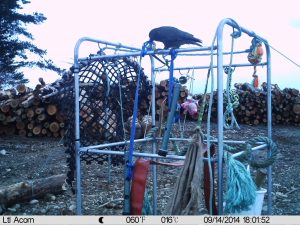
Show transcript:
Welcome to Strange Animals Podcast. I’m your host, Kate Shaw.
This is our fifth annual updates episode, where I catch us up on new studies published about various animals we’ve talked about before. This is mostly just whatever happens to catch my eye and isn’t comprehensive by any means. Also, because things have been so busy for me the last few weeks, I decided to just go with what I’d already finished and not try to add more.
We’ll start as usual with corrections, then do some updates, then learn about a parrot from New Zealand, which was a suggestion from Pranav. This part of the episode started as a Patreon episode from 2019, so patrons, I promise your October bonus episode will be brand new and interesting and in-depth!
First, both Llewelly and Zachary pointed out that there are lions living in Asia, not just Africa. It’s called the Asiatic lion and these days, it only lives in a few small areas in India. It’s a protected animal but even though their numbers are increasing, there are probably still no more than 700 Asiatic lions living in the wild.
Next, Nicholas points out that vitiligo isn’t a genetic condition, it’s an autoimmune disorder that can be caused by a number of different diseases and conditions. You still can’t catch it from other people, though. We talked about vitiligo briefly in episode 241, about squirrels. Nicholas included a link, which I’ll put in the show notes for anyone who’s interested in learning more.
For our final correction, Simon questioned whether there really are only six living species of macaw known. This was polite of him, since I was completely wrong about this. In fact, there are six genera of macaws and lots of species, although how many species there are exactly depends on who you ask. Since this mistake made it into the Beyond Bigfoot & Nessie book, I am very irritated at myself, but thank you to Simon for helping me clear this up.
Let’s start our updates with the animal who gets an update every single time, Tyrannosaurus rex. A study published in February 2022 examined the fossilized remains of 37 T. rexes and suggested that there may actually be three distinct species of T. rex instead of just one. The study focused specifically on differences in teeth and leg bones that don’t seem to have anything to do with the individual’s age when it died or whether it was male or female.
However, in July 2022, another study found that all the T. rexes found so far do indeed belong to the same species. This is how science works, because new information is always being discovered and that means we have to reassess the things we thought we knew.
In other dinosaur news, in episode 240 we talked about the last day of the dinosaurs. Results of a study released in February 2022 suggest that the asteroid struck in early spring in the northern hemisphere. The asteroid hit the earth so hard that it rocked the entire continental plate that it struck, which caused massive waves unlike any other waves, since all the water above the continental plate was pushed upwards at once. This pushed all the sediment lying quietly on the bottom of the ocean up into the water, so much of it at once that it actually buried a lot of fish alive. The same thing happened in lakes and every other body of water. The fossil site we talked about in episode 240 is still being studied, the one that appears to date to literally the day of the asteroid impact, and preserved soft tissues in some of the fish have been discovered. Careful analysis of the fish show evidence that they all died in early spring. Researchers suggest that the time of year may have been especially bad for many dinosaurs, who were probably just starting to lay eggs and have babies.
In even more recent last-day-of-the-dinosaurs news, in August 2022 a study was released about a newly discovered crater off the coast of West Africa. Researchers are pretty sure it was from an asteroid impact, although much smaller than the big one that hit what is now Mexico and led to the extinction of all non-avian dinosaurs. They’re also not completely certain when it formed, since it’s deep under the sea floor these days and was only discovered when scientists were examining seismic survey data of the sea floor. But it does seem to have formed about 66 million years ago, and another crater found in Ukraine is also about the same age. In other words, there may have been more than one asteroid that hit earth at the same time, either because a bigger asteroid broke into pieces as it entered earth’s atmosphere, or because smaller asteroids were orbiting the bigger one.
We’ve talked about the monarch butterfly several times, especially in episode 203. The monarch is a beautiful orange and black butterfly that migrates from the United States and Canada into central Mexico for the winter, where it gathers in huge groups. The monarch butterfly caterpillar primarily eats the milkweed plant, which contains toxins that the caterpillar stores in its body. Those toxins remain in the body even after the caterpillar has transformed into a butterfly, meaning the butterflies are toxic too. Birds and other animals learn to recognize the bright orange and black pattern of the butterfly and avoid eating it, because it tastes bad and makes them sick.
But a study from December 2021 determined that one animal does eat monarch butterflies, and a whole lot of them. Many species of mouse that live where monarch butterflies spend the winter, in a few spots in Mexico and California, will eat the butterflies, especially ones that fall to the ground either by accident or because they’re unhealthy and weak. The mice show resistance to the butterfly’s toxins.
Research into the small hominin remains on the island of Flores is ongoing, and the most recent findings shed some light on what might have happened about 60,000 years ago. The so-called Hobbit fossils have all been found at Liang Bua, a giant cave, but lots of other fossils have been found at the same site. A whole lot of those are from various species of rodent, especially rats, ranging in size from mouse-sized to ordinary rat-sized to giant rat sized, over two feet long including the tail, or about 75 cm.
Because we know a lot about the rats that lived on Flores, and in some cases still live there, we can infer a lot about what the area around Liang Bua was like over the centuries. Until about 60,000 years ago, most of the rat remains found were of medium-sized species that like open habitats. That means the area around Liang Bua was probably pretty open. But after about 60,000 years ago, there’s a big shift in what kind of rodents appear in the fossil record. More rats of smaller size moved in, ones that were adapted for life in forests, while the medium-sized rats moved out. That corresponds with other animals disappearing from the fossil record in and around the cave, including a species of Komodo dragon and a subspecies of Stegodon, an elephant relation that exhibited island dwarfism and was about the size of a cow. The Flores little people remains also vanish from the cave during this time, until by 50,000 years ago there are no signs of them.
But that doesn’t mean that H. floresiensis went extinct at that time. Researchers now think that as the land around the cave became more heavily forested, the Flores little people moved to other parts of the island that were more open. We don’t know where yet, and as a result we don’t know when exactly they went extinct. They might even have left the island completely. One neighboring island is Sulawesi, and researchers have found small stone tools on that island that are very similar to those made by H. floresiensis.
Modern humans probably arrived on the island of Flores about 46,000 years ago, and it’s possible that when they did, their small-statured cousins were still around.
We’ll finish with Pranav’s suggestion, a New Zealand parrot called the kea!
The kea is a type of parrot, but it doesn’t look much like a parrot at first glance. Parrots usually have brightly colored feathers but the kea appears more drab initially. It’s olive green with black-laced feathers, but it has bright orange feathers under its wings that show when it flies and the tips of its wings are blue. It’s a big, heavy bird with a wingspan more than three feet across, or one meter, and it has a big hooked beak like other parrots. It lives in the mountains of New Zealand’s South Island, the only parrot that lives in such a cold environment.
The kea is an omnivore but it mostly eats plants and insects. It will eat roadkill, small animals like rabbits, chicks of other species of bird, and trash. For over a century there were rumors that the kea would attack sheep, which led to the New Zealand government paying a bounty for dead keas that wasn’t lifted until 1970. By the time the bounty ended, there were only around 5,000 keas left, and even then the bird wasn’t fully protected until 1986.
So does the kea kill sheep or was that just an excuse to kill birds? Actually, the kea does attack sheep, or at least some keas do. Most of the attacks aren’t fatal, but we definitely know it happens because someone got it on video in 1992.
The keas land on the sheep’s back and pull out hunks of wool, which exposes and injures the skin underneath. Then they use their sharp beaks to dig into the wound and eat the fat from the living sheep. This can result in the sheep dying from infection and shock, naturally, so it’s no wonder sheep farmers disliked the kea. But the sheep is not an animal native to New Zealand while the kea is, plus the kea primarily eats plants—and sheep destroy the plants the kea eats, especially the ones high in vegetable lipids that provide the same high energy food that sheep fat does.
Besides, there’s some tantalizing evidence that the kea used to do the same thing to the moa, a huge flightless bird that lived in New Zealand until it went extinct after humans arrived. Moa bones dating to 4,000 years ago and found in a swamp along with lots of other well-preserved bones show markings on the pelvis that may be from kea beaks.
Like other parrots, the kea is remarkably intelligent and known for its tool use. It’s also infamous for its curiosity and willingness to disassemble things, including cars. I found an article about the kea in New Zealand Geographic that has some awesome stories about the bird, like this one that I’ll quote.
“In September 1983, the Old Pompolona Hut on the Milford Track was destroyed by flood when the pent-up Clinton River broke through its winter avalanche dam. The walking track season was only six weeks away. Planners, builders and helicopter crews worked night and day to complete a new hut complex before the first walkers arrived.
“The local clan of kea took a keen interest in all this frantic activity after a cold and quiet winter. Just what were these people up to? One bird, for whom building materials seemed to hold a particular attraction, began stealing nails. So persistent was the bird’s thievery that an exasperated carpenter chased it (in vain) over the roof of the new main hut. While his back was turned, another kea stole his packet of roll-your-owns, shredding tobacco and papers to the raucous approval of spectator kea perched in nearby trees.
“Weeks later, after the new hut had been completed, the purloined nails were discovered. They had been neatly laid in the gutters of an outbuilding’s iron roof, sorted according to size.”
The kea’s intelligence, tool use, and problem-solving abilities line up with those in corvids like crows and ravens. Studies show that corvids are more successful figuring out tasks that require them to make pecking motions in one way or another while parrots, including the kea, are more successful when the tasks require pulling motions. This makes sense, since parrots have a hooked beak that they use to pull things apart, like rotting logs to get at grubs, while corvids have straight beaks that they use to stab through things to find food.
The kea is also really sociable. Young keas play together, often using items as toys. For instance, from the same article, witnesses at a ski resort watched a kea steal a plastic mug, fly off with it, and start up a game of catch with it with a group of other keas.
The kea even has a particular call it makes to encourage other keas to play. In a recent study, when the call was broadcast to some captive keas over a loudspeaker, the keas immediately started a game of chase. Researchers think the call isn’t so much an invitation to play but is more like laughter which makes other keas want to laugh along, or in this case play.
This is what the play call sounds like:
[kea call]
The kea builds its nests in burrows it digs in the ground, with some burrows 20 feet long, or 6 meters. The nesting chamber is lined with soft plant material. Females lay two to five eggs, which hatch in about three weeks. Despite the parents’ care, more than half of babies don’t survive their first year, mostly due to introduced predators like rats, stoats, and possums. But if a kea survives to grow up, it can live up to 50 years or possibly more.
Young keas, like young adult humans, can cause a lot of mischief that sometimes leads to tragedy. A lot of keas are killed by cars because they find cars and roads interesting. They especially like to move road cones, which of course is also dangerous to humans. One community set up a kea jungle gym well off the road to give keas a safe place to play, and it succeeded so well that other communities have built kea jungle gyms too.
Kea numbers are improving slowly, with an estimated 7,000 individuals alive today. Part of the problem is that keas find humans interesting. They like our things, which they want to steal or destroy, and they like our junk food, which they want to eat. In other words, they’re suspiciously like us. Only they can fly.
You can find Strange Animals Podcast at strangeanimalspodcast.blubrry.net. That’s blueberry without any E’s. If you have questions, comments, or suggestions for future episodes, email us at strangeanimalspodcast@gmail.com. If you like the podcast and want to help us out, leave us a rating and review on Apple Podcasts or Podchaser, or just tell a friend. We also have a Patreon at patreon.com/strangeanimalspodcast if you’d like to support us for as little as one dollar a month and get monthly bonus episodes.
Thanks for listening!
